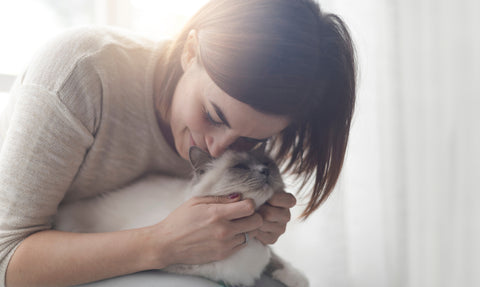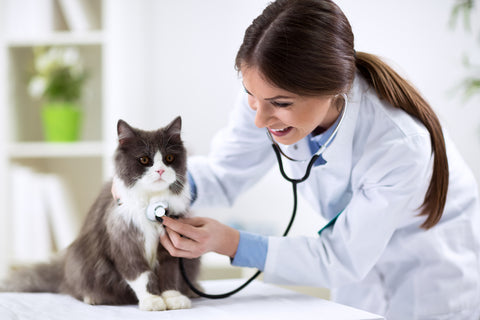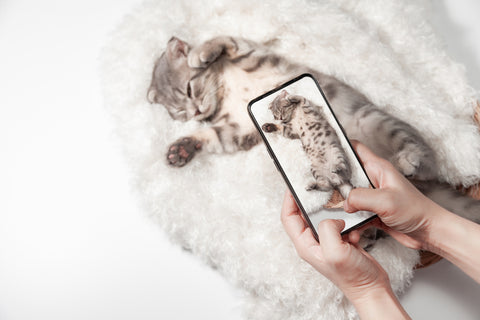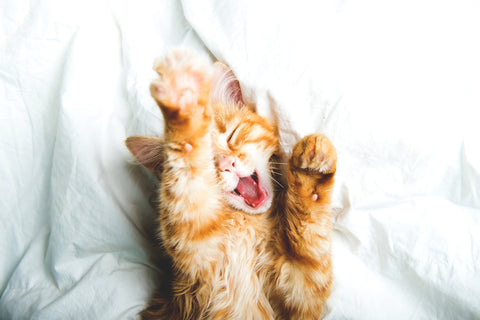
As winter weather arrives and temperatures are falling, it's a natural reaction for us to turn up the heat and put on some extra layers. Unfortunately, this is not an option for our cats who rely on their fur coats to keep them warm. While some cat breeds have longer and thicker coats, other kitties may need some extra attention during the cold months of the year. In today’s post, we’ll answer the question, do cats get cold? We will also provide you with tips to help keep your cat cozy and warm!
Do Cats Get Cold Easily?
According to Michael Arpino, DVM at the Veterinary Wellness Center of Boerum Hill, “most cats handle cold temperatures very well. Cats who are used to spending a lot of time outdoors know when it's time to come back in.” However, it is advised that you keep your cat indoors if extreme temperatures are expected in your area.
Most cat breeds can acclimate to cold temperatures fairly well, thanks to their coats of fur. However, this is only relevant when temperatures change gradually, as rapid temperature dips can be dangerous to your feline friend. With gradually changing weather, cats' fur coats respond and thicken to protect them from the approaching colder months; sudden changes in weather will not give cats this opportunity to prepare.
While temperatures outside your home tend to be much lower than inside, it is just as important to be aware of where your cat might be in your home during the colder seasons. Cats have a way of getting into places where they shouldn’t, and may find themselves in cold spaces where they have a harder time staying warm. This is certainly something to keep an eye out for, especially if you’re a pet parent of a cat with no hair or a thinner coat, or of a cat that is underweight. These factors can dramatically affect your cat’s ability to regulate its body temperature.
Common Signs That Your Cat Is Cold
Hypothermia and frostbite are both real threats to your cat, so it is important that you can spot the signs that your feline pet is cold. Cats with low body temperatures can fall into a coma or even die if left untreated for too long. Below are some of the common signs your cat might display if they are cold:
- Hunched body, with their paws, tucked underneath
- Shivering
- Refusing to move or play around
- Loss of appetite
- Seeking warm places to rest, such as beneath covers, next to a heater, or in sunlight.

Factors That Could Make Your Cat Sensitive To Cold
At certain temperatures, all cats will get cold at some point, but certain factors can cause some cats to be more sensitive to cold temperatures. The first that will eventually affect all cats is their age. Senior cats are unable to regulate their temperature as well as they once could, so slight temperature changes could cause them to feel cold, possibly leading to hypothermia if it goes unchecked. Older cats are also likely to experience weight loss, which will adversely affect their ability to regulate body temperature and keep warm.
Breeds of cats that originated from cold climates, such as the Norwegian Forest Cat or the Maine Coon, tend to have much thicker coats of fur to help them stay warm in cold temperatures, while those from warmer climates may not. Although cats' fur coats can thicken during the winter months, some breeds are unable to produce an adequate coat that will keep them warm even in milder temperatures.
The size and weight of a cat directly impacts their ability to regulate their temperature. Smaller cats are more sensitive to the cold, as they have less body fat to help them keep warm, while those with more body fat typically enjoy greater protection from the cold.
The final factor you should be aware of is an underlying medical condition that your cat may have. For example, hyperthyroidism in cats can lead to weight loss and various changes in their coats, which often leads to greater sensitivity to the cold.
How Cold Is Too Cold For Cats?
As a general rule, it is advised that you make an extra effort to keep your cat inside when the outside temperature falls below 45 degrees Fahrenheit (°F). However, Patty Khuly, DVM states on PetMD that healthy cats are more than comfortable spending time in cold weather, even when the temperatures drop beneath 45°F. According to Dr. Khuly, it’s typically “only the sickest and most exposed cats are seriously at risk.”
Pet parents should be more cautious when the outside temperature dips below freezing (32°F). At this temperature, the potential for your kitty suffering from hypothermia and frostbite is greater, especially if your cat has any of the previously mentioned factors that can cause them to be more sensitive to the cold.
How To Keep Your Cat Warm During Colder Seasons
For some pet parents, the colder months can not be avoided depending on where you live. However, this does not mean that you have to spend the entire season worrying about your cat's health when it comes to the cold! Fortunately, there are a variety of easy things you can do to keep your cat warm and comfortable during the colder seasons.
Dress Your Cat Up

A simple way to help protect your cat from the harsh temperatures is the same way we as humans would stay warm also, and that's by dressing up. Dressing your cat in a thermal coat or sweater adds an extra layer of protection that works alongside its fur coat. Although some cats may not be entirely happy with a sweater on, you can try positive reinforcement to encourage them—but don’t ever force it. Some cats will never like to be dressed up, and for others, it may take more time to adjust to a new layer on their body.
Get Your Cat A Cozy Bed
We all love getting into a cozy bed at night or whenever we fancy a quick nap, and your cat will appreciate it just as much in the winter months. Although a bed with thicker materials may cost a little more than the usual cat bed, it is a very efficient way of making sure your kitty stays toasty.
Elevate Their Bed
If your cat has a bed, simply elevating it off of the floor can help keep them away from cold drafts and raise the temperature surrounding the bed slightly. Since heat rises, placing your cat's bed on a table or chair will help keep them warmer.
Choose A Sunny Place For Your Cat To Rest
Even if it is cold outside, placing your cat's favorite bed or place to rest in the sunshine is a simple and effective way to help your cat’s temperature stay regulated.
Try A Self-Warming Or Heated Bed
While providing your cat with a regular cozy bed can be very helpful, you can go the extra mile by purchasing a self-warming or heated bed. If you live in a particularly cold climate, a heated bed might be the best option for keeping your cat warm.
Keep Your Cat Under A Blanket
We all know that more layers provide better heat retention, with each layer providing a blanket of warm air. You can provide your cat with an extra layer by using a blanket to cover them when they are resting.
Adjust The Indoor Temperature
Some of us money-savers may be reluctant to turn the heating thermostat up a few notches, but your cat will certainly be grateful if you do!
Limit Outdoor Time
The longer your cat spends outside in the cold temperatures, the lower their body temperature will drop and the longer it will take for them to warm up once inside. Limiting the time that your cat spends outside will help prevent them from losing too much body heat.
Play With Your Cat More
Engaging with your cat and encouraging them to play can help raise their temperature and keep them warm. A fun play session is beneficial to keeping your cat warm and active during the cold months when they have limited chances to get out and exercise, and it provides extra bonding time!
Feed Your Cat A Bit More
During the colder months, your cat’s body has to work much harder to regulate its temperatures, burning more calories. You can help provide the extra calories they are using to stay warm by feeding your cat a little more during the cold season—however, it is always best to discuss this with your veterinarian and still monitor your cat’s caloric intake.
Conclusion
After reading the provided information, you should know the signs of whether your cat is too cold and how you can help keep them warm and cozy in colder weather. Monitoring how your cat behaves and appears on a daily basis also helps you to better understand what changes you may need to make at home to keep them more comfortable, or when it may be time to schedule that regular wellness visit with your veterinarian—no matter the season!
Get To Know Your Cat Better With Basepaws

Basepaws provides pet parents like you with information and resources so that your cats can live their happiest and healthiest lives. We hope that you found the topics discussed in this blog useful and feel better equipped to protect your cat from the cold!
A diverse selection of topics are discussed on the Basepaws platform, providing you with a comprehensive understanding of how to best care for your cat. You can also join the Basepaws Cat Club on Facebook and connect with other cat parents and learn about fun and informative webinars and other events.
Basepaws is also here to help you get to know your cat better—both inside and out—with our Breed + Health Cat DNA Test and Oral Health Test for Cats, which give you a comprehensive overview of every aspect of your cat's health. By knowing what feline diseases your cat may be susceptible to, and how their oral health connects to their overall health, you can be proactive and support your cat’s well-being to help them live a better life, even longer!



